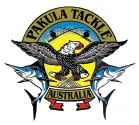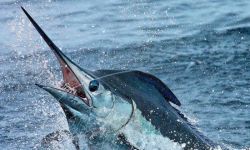There’s nothing quite like the thrill of spotting a marlin on the horizon or feeling the powerful tug of a tuna on your line. Game fishing—also known as sport fishing—is one of the most exhilarating outdoor adventures an angler can experience.
But for beginners, it can also seem intimidating. Where do you start? What tackle do you need? And how do you prepare for your first big catch?
Whether you’re setting out from the coast for your first deep-sea trip or curious about how to game fish, this guide breaks down everything you need to know. From planning your trip and choosing the right fishing tackle to understanding lure setups and safety gear, these beginner-friendly fishing tips will help you confidently hit the water.
What Is Game Fishing?
Game fishing, or recreational fishing, targets large pelagic species such as marlin, tuna, sailfish, and swordfish. Unlike casual shore fishing, game fishing takes place offshore in deeper waters and requires a mix of skill, patience, and specialised equipment.
For beginner fishing enthusiasts, the best way to build confidence and skill is to start with smaller targets and gradually work their way up.
Planning Your First Game Fishing Trip
Every successful fishing trip begins long before you step on the boat. Research, preparation, and local insights are essential to improving your chances of success.
1. Research the Right Locations
Fish behaviour changes with the seasons, water temperature, and ocean currents. Use online resources, fishing forums, and apps that provide live catch reports to identify active fishing zones.
Pro Tip: Start with regions known for beginner-friendly fishing opportunities. Local tackle shops and game fishing clubs often share updates on seasonal hotspots and lure recommendations.
2. Read Sea Surface Temperature (SST) Charts
SST charts help you locate warm, blue-water zones where fish like marlin and tuna are most active. Look for areas where temperature breaks occur—these are often prime feeding zones.
3. Seek Local Knowledge
Visit a nearby fishing tackle shop or speak to experienced local anglers. They can provide valuable fishing tips about productive spots, best lure colours, and how to approach changing weather or current conditions.
Essential Fishing Tackle for Beginners
The right fishing tackle is crucial for learning how to game fish effectively. While it’s tempting to invest in expensive rods and reels, beginners are better off starting with reliable, well-balanced gear that’s easy to handle.
Rods, Reels, and Lines
Choose a sturdy rod that matches your reel’s line class, ensuring proper balance and control. Your reel should have a smooth drag system and a minimum line capacity of 600 metres.
For beginners:
- Line strength: 24–37 kg (50–80 lb) monofilament or braided line
- Leaders: Use fluorocarbon or monofilament leaders for reduced visibility in clear water
Braided lines provide excellent sensitivity, while monofilament gives better stretch and forgiveness when battling a fish.
Hooks, Lures, and Rigging Basics
Your tackle box doesn’t need to be complicated to start. A few essential components can ensure a productive day on the water.
Must-Have Items for Beginners
- A range of hook sizes for different fish species
- Pre-rigged or skirted trolling lures
- Swivels, snaps, and shackles for secure connections
- Leader protectors or tubing to minimise line wear
When setting up your lure spread, vary the lengths behind the boat to mimic the movement of natural baitfish. Smaller lures often attract striped marlin, yellowfin, and smaller tuna—perfect for those new to game fishing.
Safety Gear and Fish Handling
Safety should never be an afterthought. Proper handling tools protect you and the fish, especially when practising catch and release.
Essential Safety Tools
- Leader gloves: For grip and protection when handling line or leader
- Tag poles: Ideal for tagging and releasing fish safely
- Gaffs: Fixed or flying gaffs for secure fish control
- Fighting belts and harnesses: To reduce strain during long fights
A well-equipped deck ensures that even a beginner’s fishing trip runs smoothly and safely.
Boat Handling and Lure Placement
Poor lure placement can make or break your fishing success, no matter how advanced your tackle is.
1. Lure Positioning
Place lures on the boat’s pressure waves—typically one-third up or two-thirds down each wave—to create natural swimming motion. Keep an eye on the wake to ensure lures stay visible without skipping too close to the surface.
2. Boat Speed
Most lures require a trolling speed of 6.5–7.5 knots. Adjust your throttle slightly to test different swimming actions until you find what works best.
3. Stay Flexible
If an area isn’t producing, move to another spot. Fish are constantly on the move, and successful anglers adapt quickly.
Why Choose Pakula for Your First Game Fishing Adventure
At Pakula Tackle, we’re more than just a fishing tackle supplier — we’re your partner in adventure. Our hand-crafted lures and accessories are designed for performance, precision, and durability, helping anglers of all levels succeed on the water.
We offer a wide range of products, including:
- Polyurethane and Paua Hothead lures
- Dojo Peche and Original Hothead skirts
- 3D head and fish-print lures
- Hooks, gloves, rigging kits, and accessories
But we don’t stop at gear. We also provide an extensive library of educational resources, But we don’t stop at gear. We also provide an extensive library of educational resources, including video tutorials, webinars, and live support to help you master every aspect of how to game fish.
Ready to start your game fishing journey? Explore Pakula’s premium lures, tackle, and tutorials today!

